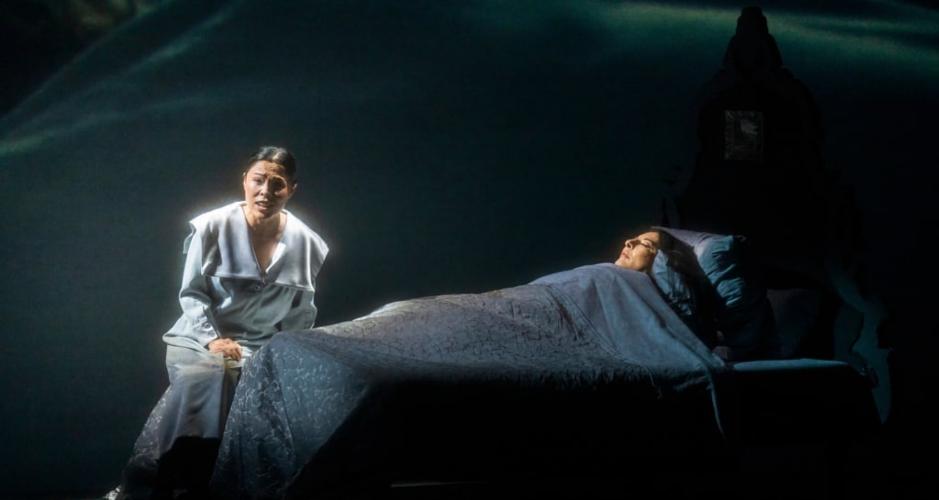Marina Abramovic gets to grips with the gruesome side of opera. She begins as Maria Callas, a soprano with a voice so expressive it led to performances in New York, Rome and London. She sang the greats - Verdi, Bellini and Rossini, Massenet and Mozart. She became the original diva. Her personal life - rivals with fellow opera singers, love affairs with millionaires and open rows with her mother - led to media obsession so heated it almost overshadowed her singing career. Her nickname La Divina ("the Divine One”) meant her life offstage as well as on.
This production Seven Deaths is a celebration of her talents and most famous roles. The seven deaths refer to heroines Callas sang night after night to audiences around the world.
Opening to an empty stage, Marina Abramovic, as Callas, is asleep in bed. On a screen that fills the entire stage, a film plays. It is the dramatic last moments of poor Violetta, the heroine of Verdi’s La Traviata. Her tragic death from tuberculosis where she is briefly reunited with Alfredo, the lover she selflessly gave up for the sake of his sister’s reputation, is dramatised by Abramovic. On stage, soprano Eri Nakamura sings Violetta’s aria from Act 3, “Addio, del passato”.
In the second death, Elbenita Kajtazi, principal singer of the Hamburg State Opera sings Tosca’s aria “Vissi d’arte”. It is arguably the most moving moment in all opera where Tosca, a singer herself, declares she has only lived for Art and for Love. Usually, it brings audience members to tears. In this production, in a video at the back of the stage, Abramovic stands at the top of a brutalist modern building wearing a gold sequin dress, bright red lips dramatic against her paper white skin. At the aria’s pinnacle, Abramovic falls forward and in slow motion, plunges, like Tosca, to her death.
The third death is Desdemona who is strangled, here not by her husband Otello as in the known version, but by an enormous yellow python that wraps itself around Abramovic’s neck as her husband looks on.
The death toll continues. Famous suicides and cruel murders see the great stars of the world’s most potent and popular operas die in dreadful ways. Arias and the accompanied dramatic film follow, from Madama Butterfly (stabs herself when her heartless American husband comes home after years of separation, married to someone else, only to abduct their son). Carmen, (stabbed by Don José after a row over her new passion the Bullfighting toreador) Lucia di Lammermoor (driven mad by her brothers and brutally driven to her Scottish highland death) and Norma. Not sure what happens to her. The film screen then lifts and Callas wakes up in bed, her Paris apartment surrounds her. She gets out of bed, her dark hair cascades around her shoulders. Abramovic’s actions are directed by her own voice, which comes through a tannoy system and she walks across the room, picks up a vase of flowers and drops them on the floor, shards of glass covering the floor. Abramovic walks barefoot across the broken glass, the window of the apartment opens to bright sunlight to represent Maria Callas’ own premature demise - she died alone of a heart attack in her Paris flat.
Much of this performance was extremely moving - moments where women for whom death feels like the only way forward, or even worse killed by someone she clearly loved. For opera buffs familiar with these celebrated roles, they probably felt this ten-fold. They know the context for each character and their decisions, the tragic buildup to the moment Don Jose stabs Carmen, for example. For somewhat of a beginner to the scene like me - it wasn’t my first, perhaps my fifth, - it didn’t have the heart-wrenching bite that some people in the same audience would have had. However, there is no doubt that starring in an opera (and not singing) is an extreme move worthy only of Abramovic, for she is an artist and performer who has more than a passing interest in the macabre and the extremes of pain and death.
Just a short taxi ride away, her solo show is still selling out at the Royal Academy, a retrospective that shows her years of performance art. Perhaps her most famous performance in the 1970s, she sat in a gallery surrounded by different objects - bowls of grapes, knives, brushes, nails, feathers - and audience members were encouraged to use them on her as they wished. They began by feeding her grapes, then after a few hours, they were cutting off locks of her hair as keepsakes then actually cutting her, a sadistic mob mentality seeping into the gallery walls.
With her fellow artist lover, they arranged to walk the Great Wall of China from either end and then when meeting in the middle, get married. The vision was to make an art piece out of their marriage, the beginning and continuation of their artistic life together, reunited after a long walk, never to be parted. When the artistic moment came, their relationship was coming to a close. They walked towards each other, then when meeting said goodbye and both kept walking into their life without eachother.
The New York Times negatively reviewed The 7 Deaths of Maria Callas, complaining that it is about Abramovic, not Callas and that the arias were mere soundtracks to the videos. But this is art, it is experimental and not perfect. This is a brilliant round-up of the fate of so many fictional heroines and it surely reflects the rough deal of so many women in real life. Good attempt to make an entertaining show - and a very potent point about the historical tragedy of so many women’s lives then and now in fiction and In reality.
Also, what better way to prove that London can fill two opera houses, and needs both. The English National Opera and Coliseum might be little sisters to the Royal Opera House, but isn’t a bit of rivalry healthy for everyone in our capital’s cultural landscape? A full house on a Thursday night is surely proof that the appetite for experimental, surprising art is sharper than ever.
Review: Caiti Grove

